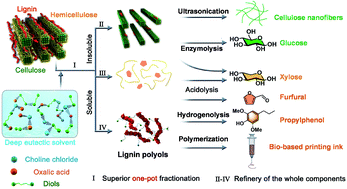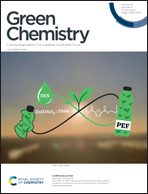Tailored one-pot lignocellulose fractionation to maximize biorefinery toward versatile xylochemicals and nanomaterials†
Abstract
Efficient fractionation of lignocellulose and refinery of all its components remain challenging. Here we describe the use of diol-tailored deep eutectic solvents for superior lignocellulose fractionation and maximizing the refinery efficiency. Near-quantitative cellulose extraction from lignocellulose was achieved after a one-pot treatment, while excellent solubilization of lignin (92%–96%) and hemicellulose (85%–89%) was achieved simultaneously. For downstream valorization, up to 99% glucose yield was obtained after enzymatic hydrolysis or quantitative cellulose nanofibers were obtained by ultrasonication of the cellulose fractions. Hemicellulose was selectively converted to furfural and xylose with up to 67% yield. The lignin fractions were easily recovered with yields up to 70% and showed diol-alkoxylated and aryl-ether-retained substructures suitable for the production of alkylphenol monomers or direct use as natural polyols for printing ink synthesis. This work demonstrated that tailored deep eutectic solvent fractionation allows 85% refinery of lignocellulose, which represents a breakthrough toward holistic and highly efficient biorefinery.



 Please wait while we load your content...
Please wait while we load your content...